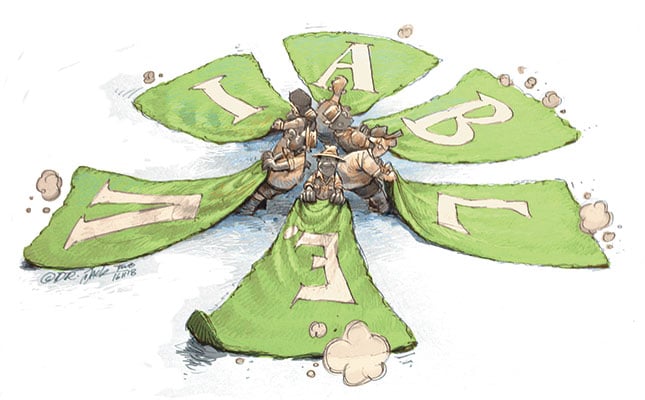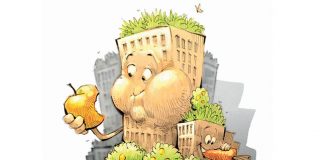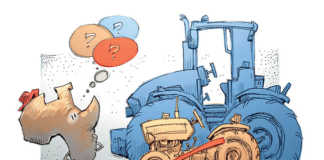
With its well-established commercial farming sector, South Africa is well ahead of the rest of Africa in terms of self-sufficiency in food production. The rest of the continent produces only half the food it needs.
By contrast, South Africa’s subsistence farming areas in the former homelands are virtually out of production, by all accounts. We do not have a vibrant, small-scale farming culture.
READ MORE How to be a good stockman
It is of course misleading to equate small-scale with subsistence, and large-scale with commercial farming. The average farm in the US, for example, is only 180ha. The critical criterion should be productivity per hectare. A commercial farmer is any farmer who, regardless of
A commercial farmer is any farmer who, regardless of size of operation, produces at, or not too far below, the median rate of production per hectare, for the crop or livestock concerned.
However, given the fact that our climatic and soil conditions are vastly inferior to crop-growing areas in the US, there is no way in which half-a-million farmers can be sustained on an average of 100ha each.
Rather than try against the odds to greatly raise the production level of subsistence farming in South Africa, we should argue for property rights, even long-term leasehold, and let the market consolidate small plots into viable, commercial units.
For certain types of farming, this would be at least 1 000ha. This approach should also be used in the former homelands.
Consolidation is key
August Basson, a missionary with decades of experience among Lesotho’s subsistence farmers, ascribes to this view. He sought, and to some extent succeeded, in introducing no-till planting in that country.
His advice is that South Africa should introduce freehold land ownership in the former homelands. This will, of course lead, to the consolidation of small units and should significantly raise productivity.
South Africa should not seek to emulate China and India, with centuries of experience in high value-added, very small-scale sustainable crop farming.
In fact, with its urbanising population, China is keen to move away from this model towards more productive commercial farming, as the country is still unable to feed itself.
I foresee South Africa becoming a 75% to 90% urbanised country, with ultimately only commercial farmers. There is no reason the existing 1ha to 5ha plots cannot be consolidated into economically viable units. Commercial farmers should assist existing subsistence farmers to become modern, commercial farmers – not better subsistence farmers.
I believe the size of farms should be set by market forces, and should be at or near the median production level per hectare of proven commercial farms.
Some supporters of traditional farmers in tribal areas argue for the maintenance of the existing division of subsistence and commercial areas, and are quite happy for traditional farmers to produce, for example, 500kg maize/ha, in areas where the yield could be 5t if given commercial skills and inputs. This they justify based on cultural practices – after all, the people are happy and have minimal input costs!
I don’t believe this is the South Africa we should and can afford to aspire to.
Subsistence farming in SA
My vision for the future is that no-one should farm in such a way that their production is below 50% to 75% of the median production of established commercial farms. And achieving this on plots smaller than 100ha would be ideal, of course, as it would absorb much more labour.
But I have my doubts, given the atrophied farming culture in the tribal/traditional areas compared with that in other developing countries, not to mention our dry climate.
I am highly impressed with the pioneer farmer/mentors across our borders, but believe we are flogging a dead horse if we want to replicate this on a substantial scale in South Africa.
Firstly, we are by far the most urbanised African country south of the equator and the youth in our country generally have no farming aspirations.
Secondly, reports by social scientists such as Ann Bernstein give one the impression that subsistence farming has already faded away. Only 20% of subsistence farmers’ livelihoods are derived from their ‘farms’.
READ MORE Finding a way forward for land reform in South Africa
This means that we don’t have subsistence farmers in South Africa in any meaningful sense. Eighty percent of their income is derived from remittances received from city dwellers and government grants!
Thirdly, South Africa’s climate is considerably drier than that of most of our neigbouring countries, and it is a false hope that we will be able to greatly expand irrigation. At present, we can hardly supply urban areas with water.
Fourthly, South Africa’s arable farming land area is decreasing at 1% per year, due to mining, industrialisation, erosion and weed infestation, among others. We simply cannot afford to not produce at international standards.
Finally, South Africa is the country of choice for economic refugees from many parts of Africa. We have 55 million people to feed and several of our neighbours are dependent on local commercial farmers to supply them in times of crisis.
Economic viability
In summary, I believe that our vision should be to convert all our underproductive farming areas into economically viable units, while steadily expanding the use of technology, such as precision farming, to further enhance productivity.
This will be impossible with the approximately 500 000 existing subsistence farmers. We must move towards fully productive units, at the smallest viable level, depending on the area and type of farming.
Surely, we don’t want to be saddled with a situation of better, but still far less productive, small-scale, black farmers on one hand, and large-scale, highly productive, white commercial farmers. We want colour-blind farmers producing at ever-increasing, world bench-marked levels, while enhancing the environment.
I believe that the way to achieve this is to introduce land ownership (freehold or long-term leasehold) in traditional farming areas, and never relinquish it in commercial areas.
The best farmers will naturally acquire larger parcels of land, and as a natural process, will seek help from more experienced farmers. No amount of passionate mentoring can do what market forces can, without Herculean effort.
I realise my proposals are anathema to the current ruling party, which sees its strongest support coming from tribal leaders in the former homelands who don’t want to give up their power over the land.
At the very least, we must not aid and abet this faction by tolerating the introduction of unproductive, high-density farming in the existing commercial regions.
Until such time as we develop a consistently high level of farming production, it would be beneficial to seek to increase the productivity of subsistence/traditional farmers with no-till farming methods, among others.
However, we must see such intervention as damage control, and not be seduced into an impossible dream of smallholders successfully feeding the country. I believe that would be a social and economic disaster.
The views expressed in our weekly opinion piece do not necessarily reflect those of Farmer’s Weekly.
For more information, phone Willem Cronje on 082 900 4364.













